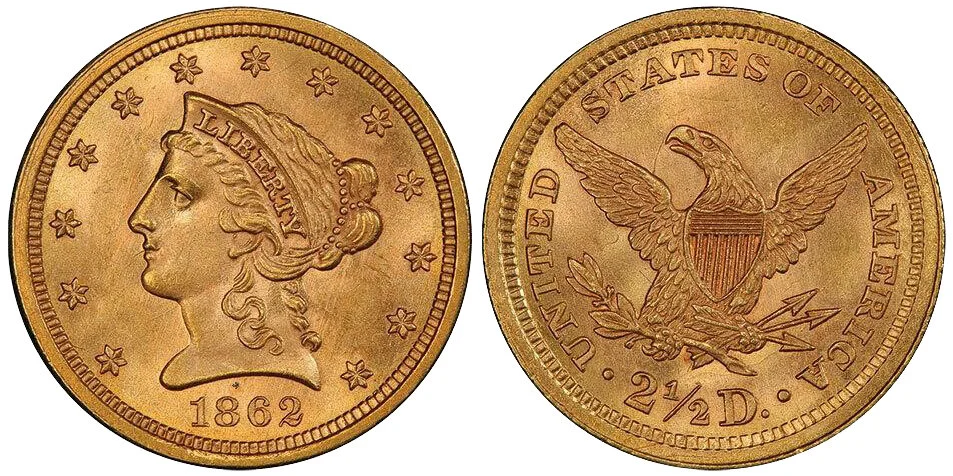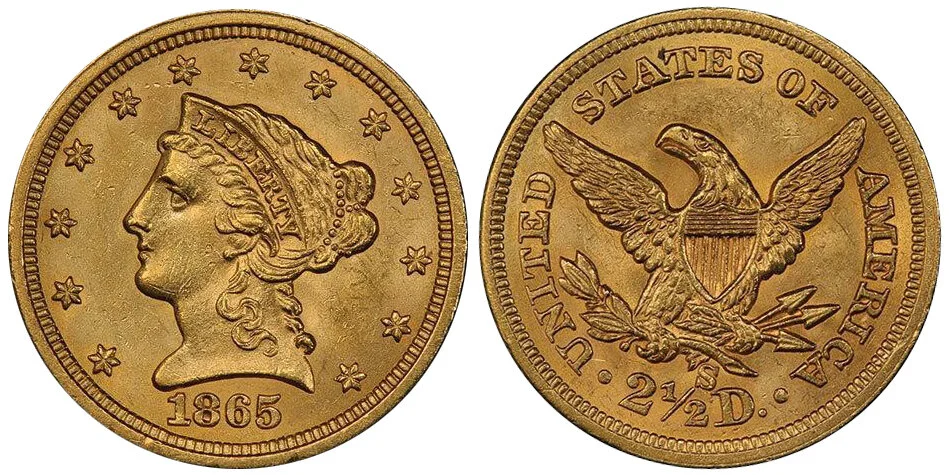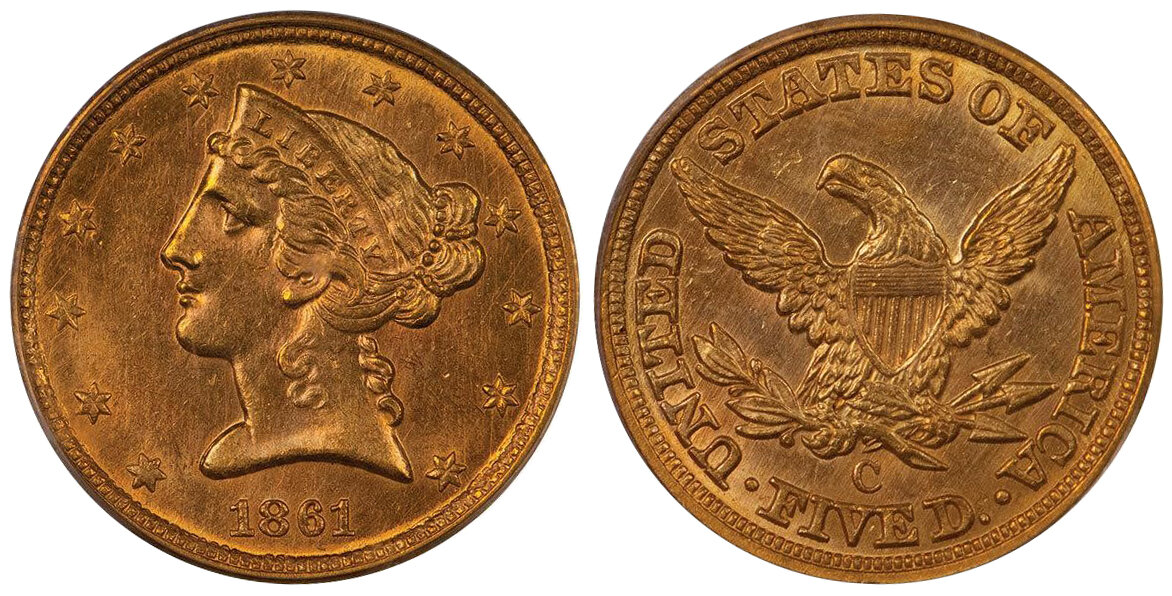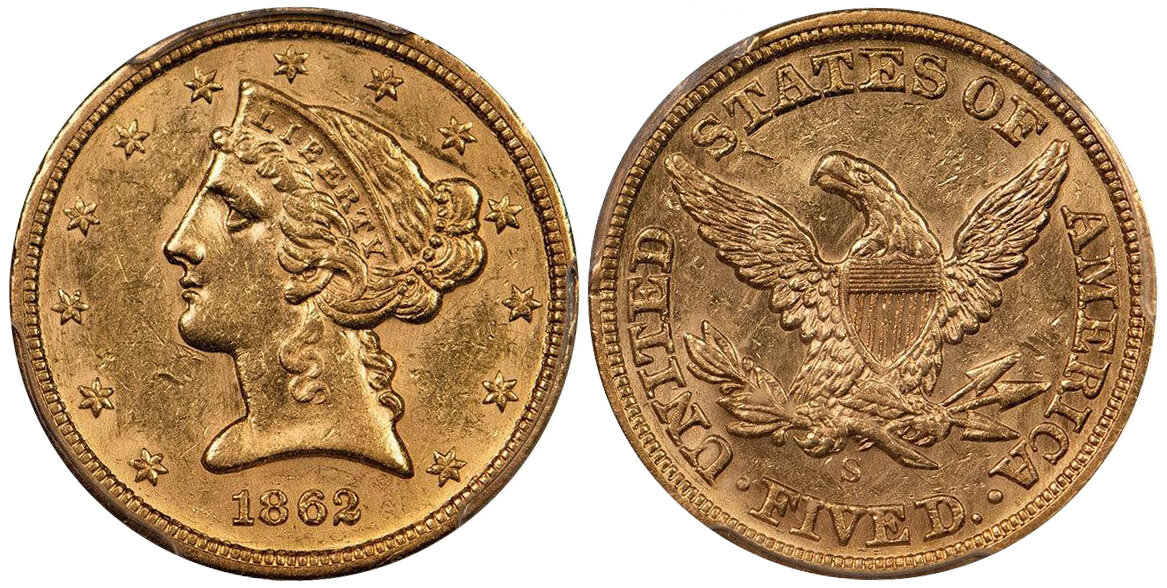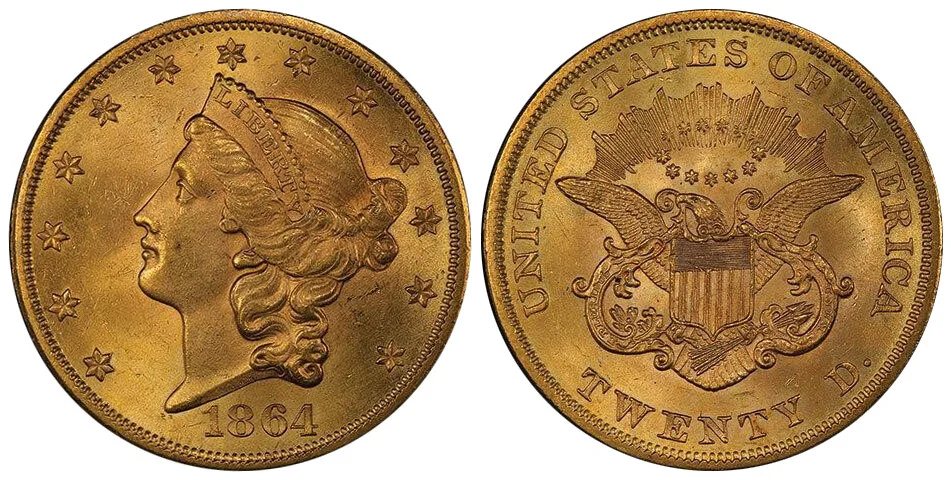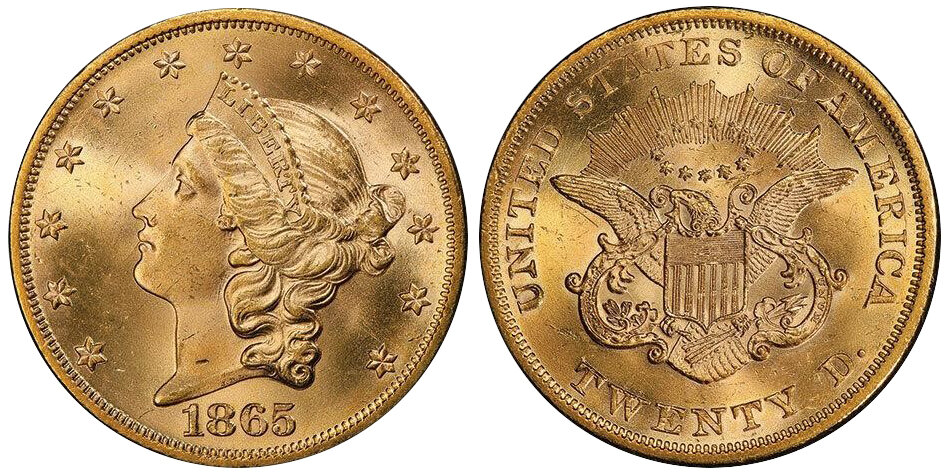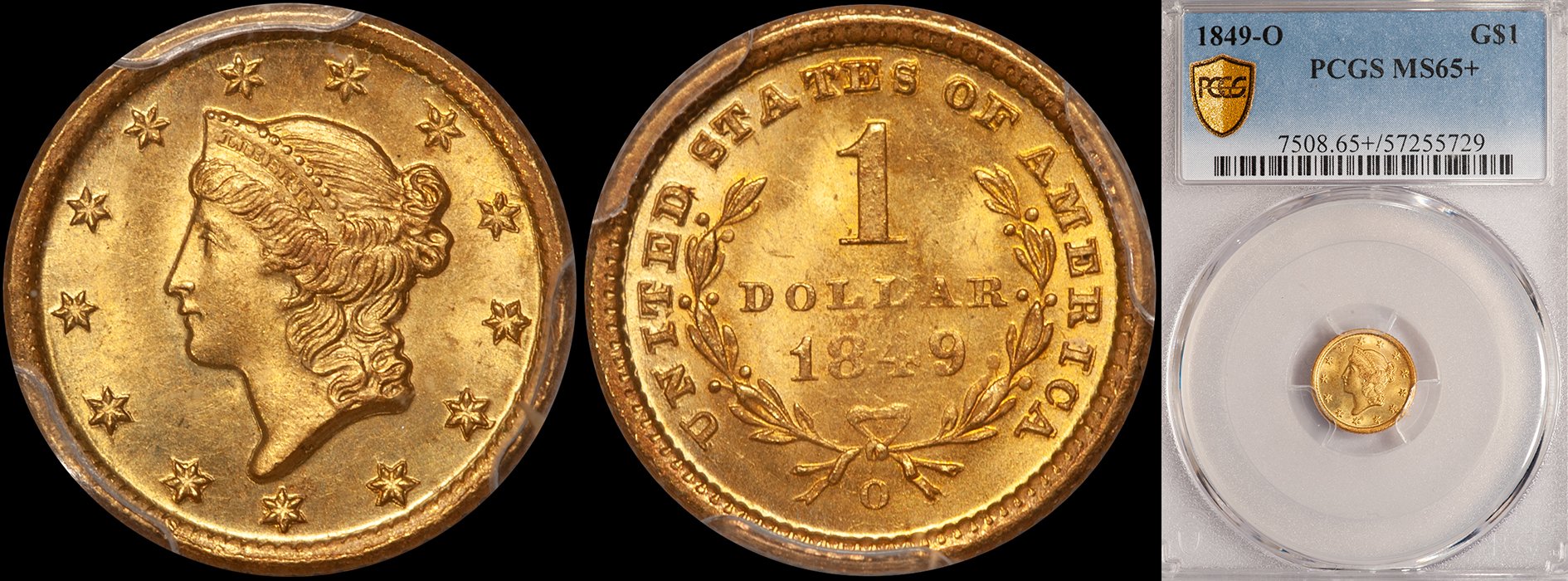The "Big Mo" Collection of Civil War Gold Coinage: Part Two
/Formed by a Nevada specialized collector over the last decade or so, the Big Mo set of Civil War coinage was likely the single finest set of these issues ever assembled. The non-gold (and certain gold coins) was sold a few months ago and the remaining coins, all gold, were recently auctioned by Legend in their 12/3 Las Vegas sale.
In this detailed analysis, we will look at this exceptional group of gold coins and determine the strengths (or weaknesses) of this market subset.
I am quite familiar with this collection as I sold the collector a number of the coins and also competed against him in various auctions over the years. There were a number of Condition Census pieces and even a few finest-knowns. Each coin was graded by PCGS and a number were stickered by CAC.
Gold Dollars
There was just a single gold dollar in this sale (the P mints had already crossed the block in the Legend July 2020 sale, which contained the first part of the collection) but it was a doozy: a lovely CAC approved PCGS AU58 1861-D which brought $73,348 (note that all auction prices include a 17.5% buyer’s premium).
1861-D $1.00 PCGS AU58, Big Mo Collection
I really liked this coin a lot. It was a high-end example with rich orange-gold color, excellent luster, and far above-average eye appeal. The price for this coin was strong although there are no good comparable APRs (auction prices realized) with no PCGS 58s having sold at auction since January 2014. There hasn’t been a CAC approved 1861-D in higher grades available in some time (I sold a PCGS/CAC AU55 in 2018), and a decent non-CAC PCGS MS60 brought $76,375 in November 2016.
I didn’t bid on this coin, but I would have been a buyer at 10-15% under its auction price.
Quarter Eagles
There were a number of interesting quarter eagles in this set. We’ll focus on four of them; all either condition rarities or absolute rarities.
At one time, I regarded the 1862 as a truly scarce date in higher grades. It has become more plentiful in the lower Uncirculated grades; possibly due to a small hoard coming on the market. This date remains very rare in MS64 and there are no Gems known.
1862 $2.50 PCGS MS64+ CAC, Big Mo Collection
The Big Mo coin was the single finest graded business strike example of this date. Graded MS64+ and approved by CAC, it had brought $35,250 as Heritage 4/2017: 15916. This time around it sold for $52,875 which I regard as an exceptionally strong price for this issue. I can’t imagine this record price will be broken any time soon.
The next quarter eagle to sell was a very nice PCGS/CAC PR65+ DCAM example of the Proof-only 1863. The owner of this collection paid a very strong $225,000 from a prominent West Coast dealer in a private treaty sale and it seemed unlikely that this coin would bring more.
1863 $2.50 PCGS PR65+ DCAM CAC, Big Mo Collection
But bring more it did, as it set a new price record for the date at $270,250.
It is likely that this coin is the second finest 1863 quarter eagle after the Simpson PR66DCAM which sold for $195,500 in 2012; a figure that now seems very reasonable.
My gut is that the 1863 is finally being recognized for the rarity that it is. With only 20 or so known, it is the third rarest Liberty Head quarter eagle after the 1841 and the 1854-S. Unlike those two dates, it is possible to purchase an aesthetically pleasing 1863 which gives it a broader range of appeal than, say the 1854-S, which is much rarer but which has just two or three extant which are reasonably attractive.
The PCGS/CAC AU58 1864 quarter eagle in the Big Mo Collection was a coin which I had the feeling was going to sell for a ton of money, but even I was pretty amazed that it brought a record-setting $111,625.
1864 $2.50 PCGS AU58 CAC, Big Mo Collection
For many years, this was an issue which I regarded as a major sleeper in the Liberty Head quarter eagle series. There are likely no more than 25-35 known and most of the examples which have been offered for sale in the last decade have been no grades. The Big Mo coin was purchased for a then-strong $79,313 as Heritage 2017 ANA: 4092. I liked the coin a lot; mainly as a result of its nice original reddish-gold color.
When this coin last sold, I felt it brought around 20% more than it should have, but this was the result of at least three collectors (ironically, all clients of mine) fighting it out to see who would buy it. This time around—only three years after it last sold—it brought 40% more.
The fourth and final significant Civil War quarter eagle in the sale was an 1865-S graded PCGS/CAC MS63+.
Unlike the 1864, this date is actually fairly common in circulated grades. In Uncirculated, it is very scarce with around 10 known. The Big Mo coin first turned-up in a November 2017 Great Collections auction where it sold for $36,001 as a PCGS/CAC MS63; a price that stunned most students of this series at the time.
1865-S $2.50 PCGS MS63+ CAC, Big Mo Collection
This time around, the price was even stronger as the coin realized $49,938.
Why did this coin bring 40% more than it did just three years ago? Digression alert!
I think there is a trend in the Liberty Head quarter series which is occurring very much under the radar. In the last few years, we’ve seen a number of finest known or high Condition Census quarter eagles bringing record prices.
What’s surprising about this is the fact that these record prices aren’t for the popular Charlotte and Dahlonega issues but rather they are for the far less popular Philadelphia and San Francisco issues. As an example, a PCGS/CAC MS65+ 1873-S just brought $40,800 in the Heritage November 2020 sale. This smashed the previous price record for this date which was $24,675 for a PCGS MS65. These are the two finest known examples of this date but the 1873-S is a reasonably available issue in the lower Uncirculated grades (PCGS has graded 20 in the MS61 to MS63 range) and this has never been a date which has been especially popular. 40k for a finest known 1873-S isn’t a totally inexplicable price but it’s indicative of a series which is quickly gaining traction.
In the same Heritage sale (11/2020), a PCGS/CAC MS65+ 1855 brought $19,200. This actually isn’t a record price for this date as a PCGS/CAC MS65 brought $20,400 in January 2018, but it’s a ton of money for a coin which is really common in the lower Uncirculated grades. I could easily cite numerous other recent price records but let’s save this for a future article.
Let’s get back to the Big Mo sale and focus on a few of the half eagles…
Half Eagles
1861-C $5.00 PCGS MS63 CAC, Big Mo Collection
A highlight of the Big Mo Collection was the finest known 1861-C, graded MS63 by PCGS and approved by CAC. I sold this coin to Big Mo for $135,000 in 2018 and it is the finest known example of the last coin struck at the Charlotte Mint by at least two points. The coin sold for $164,500 which is by far a record price for an 1861-C half eagle, and almost triple what this exact piece sold for back in 2000 (as an NGC MS63).
1861-D $5.00 PCGS MS63 CAC, Big Mo Collection
The highlight of the entire collection, in my opinion, was the lovely PCGS/CAC MS63 1861-D half eagle. This coin is likely the single finest example of this coveted issue, and it had set a previous record for any Dahlonega piece when it last brought $207,000 in the Heritage 2008 FUN sale.
Given that a nice PCGS/CAC MS62 1861-D half eagle had sold for $102,000 in January 2020, I expected this coin wouldn’t meet it seemingly aggressive reserve of $220,000. But an aggressive bidder hit the reserve a few weeks before the sale, and the final price realized was $270,250 which I believe is an all-time auction record for any Dahlonega gold coin.
Obviously I think this is a strong price. The 1861-D half eagle has been somewhat overrated in higher grades, but this issue’s multiple levels of demand ensure that it will always be the most expensive half eagle from this mint.
A few other half eagles deserve quick mention:
1862-S $5.00 PCGS MS61, Big Mo Collection
A rare PCGS MS61 1862-S sold for $42,300. This is one of just two examples of this date graded Uncirculated by PCGS (the other is an MS62) and I thought it sold pretty cheaply, considering that there is an auction record of $43,700 for a PCGS MS61 all the way back in 2006. I wasn’t really crazy about this coin, and I think its so-so quality made the sale price what it was.
The half eagles struck in 1863 are both rare, and the Big Mo coins graded PCGS MS60 and PCGS MS61, respectively. The Philadelphia coin sold for $47,000. It is one of two graded as such with just one finer; a PCGS MS61 which sold for $58,750 in December 2016. I regard this as a fairly strong price. There are just two 1863-S half eagles graded in Uncirculated by PCGS and both are MS61 coins. I wasn’t a fan of the Big Mo coin as it was very rubby on the obverse, but it still brought $49,975 which I think is a very strong price.
1865 $5.00 PCGS MS61 CAC, Big Mo Collection
Another really rare issue is the 1865 half eagle and Big Mo’s coin was an exceptional CAC-approved PCGS MS61 which sold for a strong $55,813. This coin is the finer of just two in any Uncirculated grade by this service and the price realized easily set a new record for this issue.
Double Eagles
There were two special Double Eagles in this sale, and these were an 1864 graded MS63+ by PCGS, and a CAC approved PCGS MS65 1865.
1864 $20.00 PCGS MS63+, Big Mo Collection
The last really great 1864 double eagle to sell at auction was the finest known PCGS MS65 which I purchased in April 2014 for $282,000. The Big Mo coin was the best PCGS graded example I have seen since then, and it brought $88,125 which is a pretty comparable price to the $99,000 which an NGC MS64 brought as Heritage 1/2020: 4513 (I personally liked the PCGS MS63+ more).
1865 $20.00 PCGS MS65 CAC, Big Mo Collection
While not designated as such on the holder, the PCGS/CAC MS65 1865 double eagle in this sale traced its origin to the S.S. Republic, and the only better one I’ve seen is the NGC MS66 which I bought privately around five years ago. This coin last sold for $88,125 as Lot 4575 in the Heritage April 2013 sale. Seven years later, it realized $105,750.
Civil War gold remains very popular after a decade+ run of increased demand and prices and, in my opinion, the exceptional coins in the Big Mo Collection brought very strong prices.
Do you want to be the next Big Mo? Why not work towards this goal with Douglas Winter Numismatics, the leading expert on choice and rare 19th century US gold. You can reach Doug via email at dwn@ont.com.


